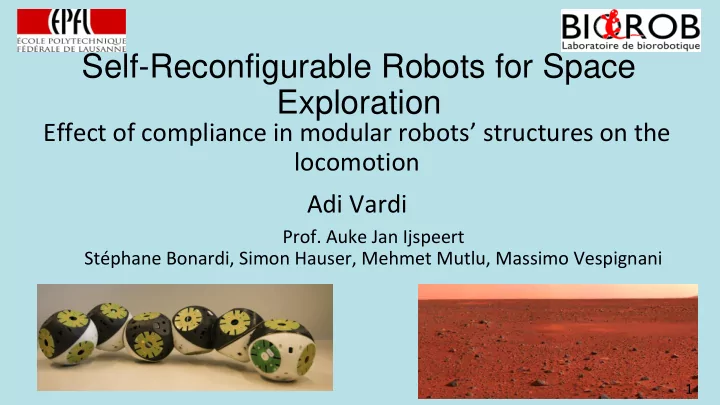

Self-Reconfigurable Robots for Space Exploration Effect of compliance in modular robots ’ structures on the locomotion Adi Vardi Prof. Auke Jan Ijspeert Stéphane Bonardi, Simon Hauser, Mehmet Mutlu, Massimo Vespignani 1
Motivation ● Final Goal : Modular robots for space exploration ● Target environment : Mars ● Means : Improve locomotion using compliant elements inside the structure 2
Project Design Choices ● Structure : Choice between Snake, Tripod, Quadruped ● Simulation platform : Webots ● Hardware : Bioloids kit 3
Project Design Choices ● Fixed structure, only stiffness varied ● Compliant element between every two joints ● Effect of compliance on the stability of the structure 4
Main steps Step 1: Modelling in simulation Step 2: Gait parameters optimization Step 3: Robustness to external disturbances Step 4: Rough terrain with compliant elements a) Systematic searches and PSO b) Analysis 5
Step 1: Modelling in simulation Modular model ● Multiple “ Robot ” nodes ● Each module is one servo motor and one compliant element ● Compliant elements modeled as ball joints ● “ Connector ” nodes ● Modules snap together ● Each module is controlled by a controller, plus a supervisor 6
Step 1: Modelling in simulation Servo Compliant motor element 7
Step 1: Modelling in simulation Terrain modelling ● Combine 13 ° slope with random roughness ● Max height: 5%, 10% of leg length 8
Step 1: Modelling in simulation 9
Step 2: Gait Parameters optimization ● Optimize controller parameters for speed and stability ● Stiff structure ● Motors are controlled with CPG ● Three parameters per motor (Amplitude, offset and phase) ● Symmetry between pair of legs ● 13 open parameters 10
Step 2: Gait Parameters optimization ● Optimization using PSO ● Each run takes 30 seconds, on 5% rough terrain ● Maximizing Fitness function ● D - Advance in the direction of movement ● d - Deviation from a straight line ● R - Stability evaluation 11
Step 2: Gait Parameters optimization 12
Step 3: Robustness to external disturbances ● Flat terrain, previously found gait parameters ● Test robustness to external forces ● Three forces at random times ● Norms of 3,4 and 5N ● 100 repetitions Very Stable 13
Step 4: Rough terrain with compliant elements ● Using compliant elements ● 7 Systematic searches (All units are Nm/rad) 5% and 10% roughness: Only 5%: ● 2 PSO: 5% and 10% roughness Stiffness: 1 - 50 ● Above 100Nm/rad practically rigid 14
Step 4: Rough terrain with compliant elements After examining the data, two hypotheses: 1. The inner compliant elements of the structure should have higher stiffness 2. The outer compliant elements of the structure should have lower stiffness Both hypotheses exclude the front leg 15
Dataset 1: Systematic search, 5% Roughness, 1-10- 100 Nm/rad Clustering by threshold Threshold: median = 16
Dataset 1: Systematic search, 5% Roughness, 1-10- 100 Nm/rad Inner Outer 17
Dataset 1: Systematic search, 5% Roughness, 1-10- 100 Nm/rad Grouping compliant elements by position in the structure 18
Dataset 1: Systematic search, 5% Roughness, 1-10- 100 Nm/rad Different clustering to explore the inner- outer patterns 19
Dataset 1: Systematic search, 5% Roughness, 1-10- 100 Nm/rad p-value = p-value < 0.05 Clusters are significantly different 20
Dataset 3: PSO, 5% Roughness, 1 - 50 Nm/rad Best five solutions 21
Videos PSO 22
Videos Worst case (Database 1) 23
Conclusions Hypothesis 1: Supported by all the tests Hypothesis 2: Present in many tests Not as clear Structure should not be too soft 24
Physical interpretation Stiff inner modules for efficient transfer of the motors ’ energy Soft outer modules for shock absorbing and improving traction by adjusting hold Structure too soft can lose its grip in the terrain Front leg has contradictory roles - No conclusive patterns 25
Conclusion and Future work Optimal stiffness value depends on position in the structure Improving the symmetry of the quadruped More dynamical gaits and structures Get closer to Martian terrain 26
Thank you for your attention 27
Recommend
More recommend